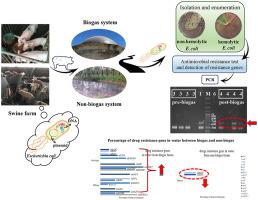Journal of Environmental Management ( IF 8.0 ) Pub Date : 2020-12-10 , DOI: 10.1016/j.jenvman.2020.111659 Atchara Dawangpa , Preeda Lertwatcharasarakul , Pongrama Ramasoota , Alongkot Boonsoongnern , Nattavut Ratanavanichrojn , Arsooth Sanguankiat , Sakuna Phatthanakunanan , Phitsanu Tulayakul

|
Currently, Thai livestock is rapidly expanding, especially the production of ruminants, chicken, and swine. The improper use of antibiotics will probably lead to an antimicrobial resistance problem. It has long been suspected that wastewater released from swine farms is a crucial aspect of the spread of antimicrobial resistance to the environment. Biogas systems are wastewater treatment systems commonly used on swine farms; however, little is known about the roles they play in the occurrence and transmission of resistant bacteria between biogas and non-biogas systems.
This study collected pooled water, wastewater, and feces samples from five biogas farms and three non-biogas farms in Central Thailand. The samples were isolated to hemolytic E. coli (HEC) and non-hemolytic E. coli (NHEC) to test the drug resistance by using VITEK® 2 Compact (BioMérieux, USA) and detect resistant genes by using the polymerase chain reaction (PCR) technique to correlate the determined phenotypic and genotypic patterns. The results demonstrated that enumeration levels of E. coli ranged from 20.1 to 70.4 (MPN/100 ml), 105 to 107 (cfu/ml), and 105 to 109 (cfu/g), while they were 0–148.7 (MPN/100 ml), 105 to 107 (cfu/ml) and 105 to 109 (cfu/g) for water, wastewater and manure from biogas and non-biogas swine farms, respectively. The amount of E. coli in the sow feces samples was higher than the samples of nursery piglets on biogas farms at a 0.05 significant level (p < 0.05). The antimicrobial resistance indicated the relevant resistance characteristics of E. coli: the highest antimicrobial resistance was for ampicillin (AMP), followed by amoxicillin (AMX), tetracyclines (TET), chloramphenicol (C), and piperacillin (PIP), respectively. Multidrug resistance (MDR) of E. coli was 15 drugs: AMP-AMX-AMC-PIP-CEX-CEV-CPD-XNL-GM-IMP-SXT-C-TE (11.9%) and AMP-AMX-AMC-PIP-CEX-CEV-CPD-XNL-GM-IMP-SXT-C-ENR-MBR-TE (18.55%), which were the most commonly found in biogas and non-biogas swine farms, respectively. The blaTEM, tetA, sul2, and sul3 were dominantly resistant genes isolated from the water from both types of farm; while, blaTEM, aadA1, tetA, dfrA12, sul2, sul3, and cmlA were isolated from feces. The amount of E. coli in the final effluent from biogas swine farms was higher than the non-biogas swine farms; however, it was not significantly different at (p > 0.05). Furthermore, the findings of study found that genotypic characteristic of HEC showed similarity 100%.
Thus, it was concluded that the levels of E. coli were accelerated in biogas wastewater treatment systems, and isolated E. coli demonstrated multidrug resistance. Even though E. coli was found in different locations, it showed relevant resistance characteristics. Therefore, regular monitoring of antimicrobial resistance on livestock farms is necessary for efficient management and drug uses on farms.
中文翻译:

泰国中部沼气猪场与非沼气猪场之间水和粪便中大肠埃希菌的耐药性基因型和表型状况
当前,泰国的牲畜正在迅速扩大,特别是反刍动物,鸡和猪的生产。抗生素使用不当可能会导致抗菌素耐药性问题。长期以来,人们一直怀疑从养猪场释放的废水是对环境的抗菌素耐药性传播的关键方面。沼气系统是养猪场常用的废水处理系统;然而,人们对它们在沼气和非沼气系统之间耐药细菌的发生和传播中所起的作用知之甚少。
这项研究从泰国中部的五个沼气场和三个非沼气场收集了池水,废水和粪便样品。将样品分离到溶血性大肠杆菌(HEC)和非溶血性大肠杆菌(NHEC)中,以使用VITEK®2 Compact(美国BioMérieux)测试耐药性,并通过聚合酶链反应(PCR)检测耐药基因)技术,以将确定的表型和基因型模式关联起来。结果表明,大肠杆菌的枚举水平范围为20.1至70.4(MPN / 100 ml),10 5至10 7(cfu / ml)和10 5至10 9(cfu / g),而它们是0– 148.7(MPN / 100毫升),10 5至10分别来自沼气和非沼气猪场的水,废水和粪便分别为7(cfu / ml)和10 5至10 9(cfu / g)。量大肠杆菌母猪粪便样品中以0.05显著水平(p <0.05)高于上沼气农场苗圃仔猪的样品更高。抗菌素耐药性表明了大肠杆菌的相关耐药性:最高的抗菌素耐药性是氨苄西林(AMP),其次是阿莫西林(AMX),四环素(TET),氯霉素(C)和哌拉西林(PIP)。大肠杆菌的多药耐药性(MDR)共有15种药物:AMP-AMX-AMC-PIP-CEX-CEV-CPD-XNL-GM-IMP-SXT-C-TE(11.9%)和AMP-AMX-AMC-PIP-CEX-CEV-CPD-XNL- GM-IMP-SXT-C-ENR-MBR-TE(18.55%),分别最常见于沼气和非沼气猪场。的BLA TEM,TETA,sul2,和sul3是从两种类型的场的水分离显性抗性基因; 同时,从粪便中分离出bla TEM,aadA1,tetA,dfrA12,sul2,sul3和cmlA。大肠杆菌量沼气猪场的最终出水高于非沼气猪场;但是,在(p> 0.05)时差异不显着。此外,研究发现,HEC的基因型特征显示出100%的相似性。
因此,得出的结论是,沼气废水处理系统中的大肠杆菌水平得到了提高,而分离出的大肠杆菌表现出多药耐药性。即使在不同位置发现了大肠杆菌,它也显示出相关的抗性特征。因此,必须对牲畜农场的抗菌素耐药性进行定期监测,以实现农场的有效管理和药物使用。





















































 京公网安备 11010802027423号
京公网安备 11010802027423号